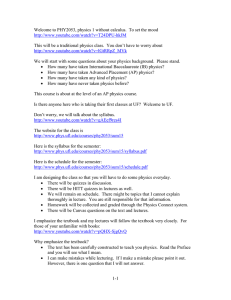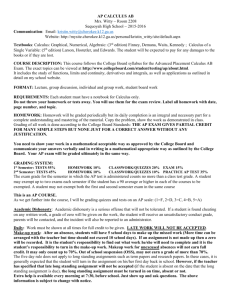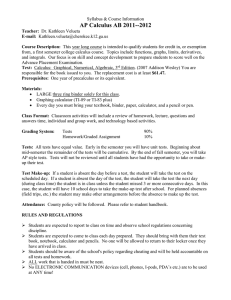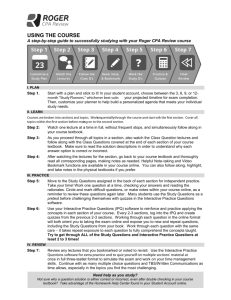Welcome to PHY2053, physics 1 without calculus.
advertisement
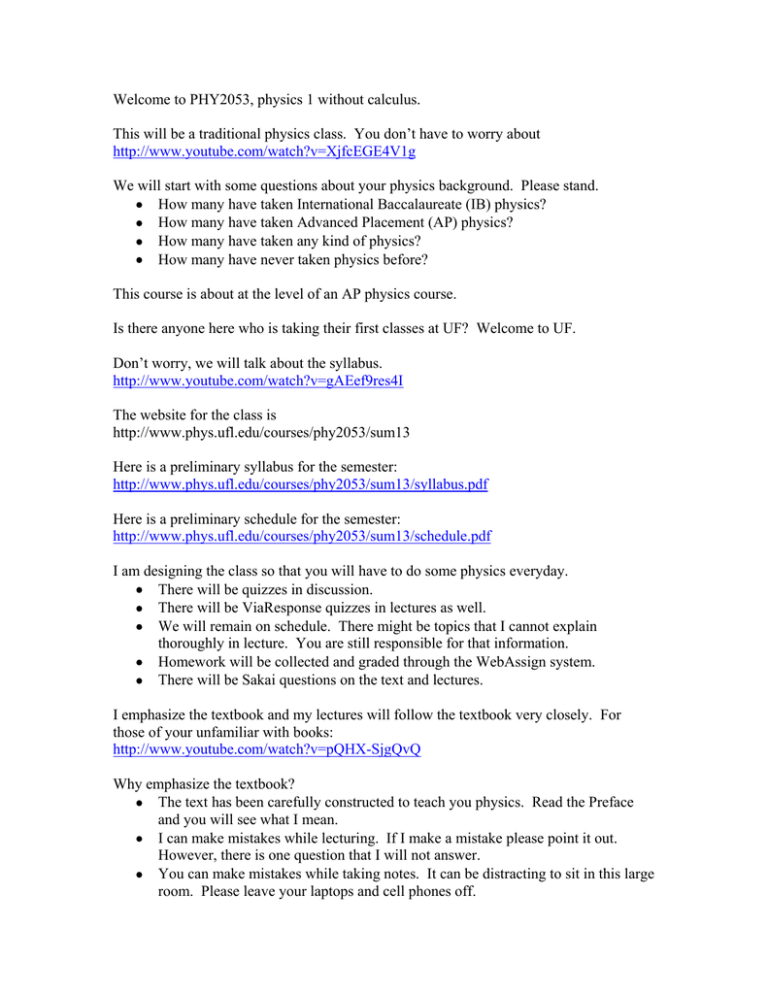
Welcome to PHY2053, physics 1 without calculus. This will be a traditional physics class. You don’t have to worry about http://www.youtube.com/watch?v=XjfcEGE4V1g We will start with some questions about your physics background. Please stand. How many have taken International Baccalaureate (IB) physics? How many have taken Advanced Placement (AP) physics? How many have taken any kind of physics? How many have never taken physics before? This course is about at the level of an AP physics course. Is there anyone here who is taking their first classes at UF? Welcome to UF. Don’t worry, we will talk about the syllabus. http://www.youtube.com/watch?v=gAEef9res4I The website for the class is http://www.phys.ufl.edu/courses/phy2053/sum13 Here is a preliminary syllabus for the semester: http://www.phys.ufl.edu/courses/phy2053/sum13/syllabus.pdf Here is a preliminary schedule for the semester: http://www.phys.ufl.edu/courses/phy2053/sum13/schedule.pdf I am designing the class so that you will have to do some physics everyday. There will be quizzes in discussion. There will be ViaResponse quizzes in lectures as well. We will remain on schedule. There might be topics that I cannot explain thoroughly in lecture. You are still responsible for that information. Homework will be collected and graded through the WebAssign system. There will be Sakai questions on the text and lectures. I emphasize the textbook and my lectures will follow the textbook very closely. For those of your unfamiliar with books: http://www.youtube.com/watch?v=pQHX-SjgQvQ Why emphasize the textbook? The text has been carefully constructed to teach you physics. Read the Preface and you will see what I mean. I can make mistakes while lecturing. If I make a mistake please point it out. However, there is one question that I will not answer. You can make mistakes while taking notes. It can be distracting to sit in this large room. Please leave your laptops and cell phones off. There will come a time when you will have to figure something out for yourself by reading an instruction manual or a book. Not everything will be on youtube or google. In the Preface there is a section titled To the Student. If you follow the suggestions found there, this could be a very successful class for you. You might learn how you learn. Here are some highlights from the To the Student section: Are you a visual, auditory, or kinesthetic learner? Get organized. Manage your time. How to get the most out of lectures. How to get the most out of your textbook. How to study for an exam. Let’s get started with Chapter 1 Okay, how many of you are interested in becoming a doctor? A dentist? A vet? Why are they making you take physics? I am not a doctor (and I don’t play one on TV) but when you go to the doctor how much chemistry do they do on you? Take your weight. Take your blood pressure. Check your reflexes. Check your eyes and ears. Maybe take an x-ray. Of course you need to know chemistry and biology, but it seems that a lot of physics occurs in the examining room. As we go through this semester, we will be learning a lot of vocabulary. Many of the words we use will be familiar: work, energy, momentum, et al. For us, those words will have very specific definitions. You will need to consider these definitions carefully. Physics will use a lot of mathematics. This course is physics without calculus. How many of you have had at least semester of calculus? I will use calculus very sparingly, but I will use it so you can see how it helps with physics. There won’t be any calculus problems on any quizzes or exams. If you look in your physics text, you’ll see a number of word problems. In my experience, most people hate word problems. You will be taught how to solve physics word problems, but you will need to practice to master them. Let us compare how physics problems will differ from math problems. In previous math courses, you had a few formulas that were handy: the equation of a line, equations of conic sections (parabola, hyperbola, ellipse, circle), the quadratic formula, etc. But much of the time you had to make up your equation. For example, let us solve this problem: The sum of 3 consecutive integers is 57. What are the numbers? Strategy: If x is the first number, x +1 and x + 2 are the next. Solution: x ( x 1) ( x 2) 57 3 x 3 57 3 x 54 x 18 The numbers are 18, 19, and 20. Now a physics problem. A 100 kg rowboat is being paddled up stream. The paddles push the boat forward with a 100 newton (N) force while the current impedes the motion with a 20 N force. What is the acceleration of the boat? We will cover this type of problem in Chapter 4. But since Newton’s laws are the cornerstone of this semester we will talk about this problem now. Strategy: Draw a free-body diagram for the boat. Fw = 20 N Fp = 100 N The net force accelerates the boat. Solution: Use Newton’s second law Fx ma x Fp ax Fw ma x Fp Fw m 100 N 20 N 100 kg 0.80 m/s 2 This time we did not “make up” the formula. But I hope that you find the formula makes sense. What are the arrows? What about the arrows pointing up and down? Units In the problem above we used the metric system. As is common in science classes, we will use the Systeme International d’Unites (SI) units. Let’s practice. 10-6 wave 10-3 pede 10-2 pede 106 bucks Converting units. How many square inches are there in one square meter? There are 2.54 cm in one inch. 1m 2 1m 2 1cm 10 2 m 2 1in 2.54 cm 2 1550 in 2 Significant figures? We will not worry about significant figures. As a rule of thumb, keep your answers to 3 sig figs. Significant figures will be more important in lab. It is assumed that you know about scientific notation. Can you make an approximation for the conversion problem? A meter stick is about 39 inches long. General Guidelines for Problem Solving (page 13) 1. Read the problem carefully and all the way through. 2. Reread the problem one sentence at a time and draw a sketch or diagram to help you visualize what is happening. 3. Write down and organize the given information. Some of the information can be written in labels on the diagram. Be sure that the labels are unambiguous. Identify in the diagram the object, the position, the instant of time, or the time interval to which the quantity applies. Sometimes information might be usefully written in a table beside the diagram. Look at the wording of the problem again for information that is implied or stated indirectly. 4. Identify the goal of the problem. What quantities need to be found? 5. If possible, make an estimate to determine the order of magnitude of the answer. This estimate is useful as a check on the final result to see if it is reasonable. 6. Think about how to get from the given information to the final desired information. Do not rush this step. Which principles of physics can be applied to the problem? Which will help get to the solution? How are the known and unknown quantities related? Are all of the known quantities relevant, or might some of them not affect the answer? Which equations are relevant and may lead to the solution to the problem? This step requires skills developed only with much practice in problem solving. 7. Frequently, the solution involves more than one step. Intermediate quantities might have to be found first and then used to find the final answer. Try to map out a path from the given information to the solution. Whenever possible, a good strategy is to divide a complex problem into several simpler subproblems. 8. Perform algebraic manipulations with algebraic symbols (letters) as far as possible. Substituting the numbers in too early has a way of hiding mistakes. 9. Finally, if the problem requires a numerical answer, substitute the known numerical quantities, with their units, into the appropriate equation. Leaving out the units is a common source of error. Writing the units shows when a unit conversion needs to be done – and also may help identify and algebra mistake. 10. Once the solution is found, don’t be in a hurry to move on. Check the answer – is it reasonable? Try to think of other ways to solve the same problem. Many problems can be solved in several different ways. Besides proving a check on the answer, finding more than one method of solution deepens our understanding of the principles of physics and develops problem-solving skills that will help solve other problems. Graphs We will use graphs throughout the semester. How about a demo?
